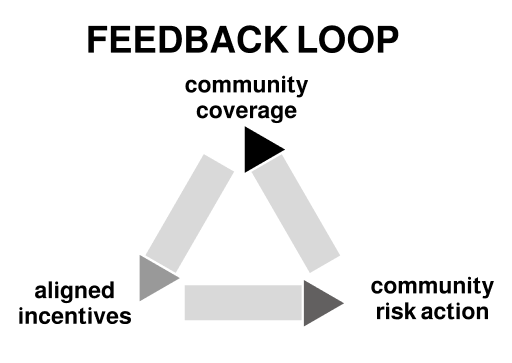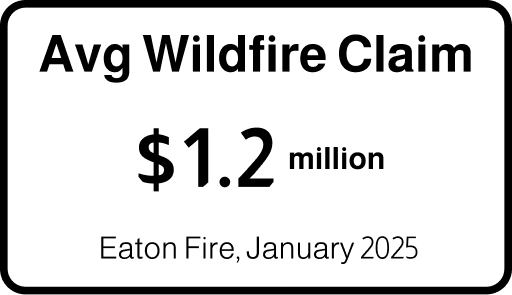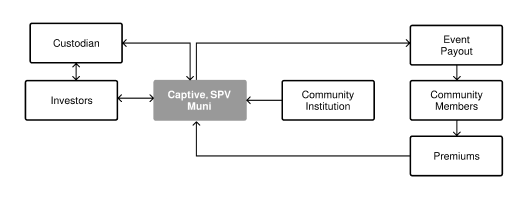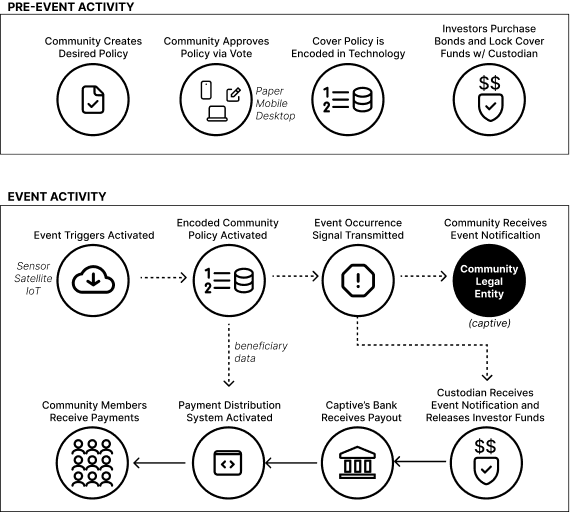Protecting Entire Communities
Capital formation & technology for wildfire coverage
Parametric Insurance for Community-Wide Coverage
Definitions:
Community Coverage
Pooling property owners within a community to create purchasing power and access to better policy structures such as a parametric insurance
+
Parametric Insurance
Policy based on an objective, measurable event (i.e., a parameter), regardless of the actual loss. This enables automatic and nearly instant financial payout
Why Community Coverage?
Unlike other natural disasters like earthquakes or hurricanes, wildfires require mitigation at a community scale to be effective in saving property, lives, and insurance costs
An unprotected property amidst ones that have taken complete risk mitigation steps is fuel for a wildfire and makes everyone vulnerable
Imagine
for Property Owners and Small Businesses
Automatic payouts—no claims battles
Complete coverage, no gaps
Eliminate financial risk of a disaster
Institutional pricing power for coverage
Everyone financially motivated to reduce wildfire risk
Imagine
for Community Leaders
Enables municipalities to de-risk their entire fiscal future
Recovery capital flowing instantly, not months later
Universal fire-safety participation
Zero coverage gaps across all properties
Economic protection for vulnerable residents
Incentive?
Insurance and Mitigation Enable Each Other
-63%
Property Destroyed
-55%
Lower Premiums
For Communities
Protect your community by pooling wildfire risk into a single legal entity—aligning incentives for effective mitigation while providing greater purchasing power and access to innovative, customizable coverage.
Complete Coverage
No gaps in policy coverage that leave communities vulnerable during disasters.
Immediate and Automatic Payouts
Policy trigger is measurable and objective and activates payouts automatically
Community Control
Local governance and decision-making determines the policy coverage details
Risk Reduction
Financial and communal incentive to harden homes and create defensible space
Financial Protection Guaranteed
Catastrophe Bond structure guarantees disaster funding is safe and easily deployed
For Investors
Directly access underwriting opportunities that didn't previously exist—when communities pool their wildfire risk, they create the financial alignment needed to incentivize collective mitigation, making previously uninsurable risk investable.
Cat Bond Structure
Familiar structure with major custody agents and well tested legal wrappers
Direct Access to Opportunities
Frontline opportunities that bypass intermediaries
Scaled Model
Single buyer at the size and scale to which institutional investors are accustomed
Lacks Adverse Selection
Risk represents an entire community versus individual high risk locations and properties
Lacks Moral Hazard
Financial and social incentives ensure hardening and defensive space are complete
The Problem: Effective Risk Mitigation Lacks Aligned Community Incentives
Although home hardening and defensible space can reduce wildfire risk by half, communities aren't implementing these measures comprehensively. Individual homeowners lack the financial incentive to invest in mitigation when their efforts depend on neighbors doing the same—and this coordination failure makes comprehensive coverage difficult to underwrite and price.
“While applying these measures to any particular structure within a dense urban area makes little difference on the survivability of a single home, substantial reductions in losses are achievable when community-wide actions can be applied.”
UC Berkeley Fire Research Lab
The Problem - Standard Policies Are Not Designed for Natural Disasters
Property & Casualty insurers traditionally built their business models around frequent, small claims where standard claims processing timelines are sufficient. Wildfire catastrophes are fundamentally different: they're infrequent, severe, affect entire communities simultaneously, and demand very large and immediate liquidity for emergency housing and rebuilding.
The Problem - Slow Money Flow Delays Rebuilding
Rebuilding times are long - very long. Some communities never recover. Recent data suggests that some communities have achieved 25% rebuild after two years and 58% after 4-6 years. Altadena CA, now 9 months post Eaton fire, has barely gotten started. Accessing financial resources and knowing the amount available to rebuild are critical variables for recovery to begin.
The Solution - Community Coverage Fills the Gaps
Financial incentive created to take risk reducing action (policy underwriting ability and cost will require it)
Social incentive created
Event payout is automatic and immediate
Payout amounts meet the needs of the community
Community designs policy terms to ensure completeness
Eliminates the “free-rider” problem (property owners that don’t invest in risk mitigation placing everyone in the community at-risk)
Communities Gain Direct Access to Institutional Investors and Reinsurers
Communities that aggregate their risk gain a direct pathway to advanced wildfire insurance solutions from the main entities that take on catastrophe risk. Further, a community policy creates scale in pricing. Investors also gain by having access to well defined opportunities, the absence of moral hazard and adverse selection, and a cat bond structure.
How it Works for Communities
Technology platform manages a community’s policy creation via a polling and voting mechanism, encodes the decisions into software, and manages the administration of cover payments and event payouts
How it Works for Investors
Investors will interact with the community’s legal entity, place bond proceeds into custody, and receive bond payments into the same custodian.
Automated Payout
Sensor, camera, and satellite data feed into the technology to monitor conditions. Once a threshold is passed, event payment is automatically triggered.
Transparent Process
All parties understand and can audit the process for decisions, actions, and money flow.
How it Works
Trigger - The community selected triggers activates an event signal
Cover Policy - The encoded policy, determined and approved by the community, processes the trigger signal to determine the payout
Signal Transmission - Signal is sent to the community’s legal entity (captive) and to the custodian of investors capital
Custodian Releases Funds - Escrowed capital is released to the community’s bank
Bank Receives Cover Funds
Payment Distribution - The bank releases funds to a payment distribution system that has the specific details of specific community members and destination banking information
Community Members Receive Coverage Payment
About our company
BoxedCover structures and finances wildfire protection for entire communities by creating direct capital pathways between institutional investors and wildfire-vulnerable areas.
Our platform empowers communities—HOAs, neighborhood associations, municipalities—to design their own protection. Community members define coverage parameters, establish objective payout triggers, designate beneficiaries, and encode these decisions into immutable software. The platform then autonomously administers real-time capital flows, eliminating intermediaries.
BoxedCover makes wildfire protection more accessible, transparent, and efficient for the communities that need it most
Contact Us
Interested in working together? Fill out some info and we will be in touch shortly. We can’t wait to hear from you!














